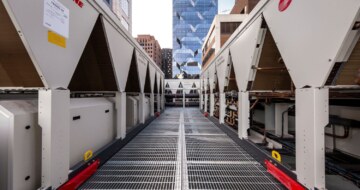
October 8, 2025 in Advisory Notes
Navigating Heat Pump Retrofits - A Guide for Facility M...
Electrification projects can be complex undertakings bringing together a range of technical elements along with planning, coordination and logistics c...
May 6, 2021
The as-built and design information from new construction projects includes Building Information Models (BIM), other digital documentation & drawings, various database files and communication records. Additionally, many existing facilities are on a pathway to digitise existing as-built records. This information typically lacks equipment and system asset descriptions of the type and granularity required for supporting lifecycle operation and management.
Operational and management systems address lifecycle planning, maintenance planning, performance recording & benchmarking and contract and regulatory compliance management. These systems also generate and store valuable digital facility data.
Another important digital information source is corporate management systems as they relate to the facility. These include financial systems, statutory safety records and business risk mitigation. The challenge for management systems is to keep pace with the changing asset lists through the churn of a facility’s life cycle.

Software systems utilise analytics algorithms to automate the discovery of insights through rigorous and detailed analysis of gathered information. In facilities, these insights can trigger the requirement for human intervention or other remediation activities. They can be used to drive improvements in system performance, system longevity and protection of assets or reductions in environmental impacts and can also support facility outcomes in occupant health and safety and business continuity.
The degree of accuracy and usefulness of the insights gained is proportional to the ability to align the information sets available for the facility. Importantly the asset description must be defined to the right level of detail to support operational and maintenance activities.
Alignment is achieved through consistent references to data or metadata enabling the analytics software to access and correctly use the information. With the full spectrum of information available, useful scenarios can be defined in the analytics software.
Application of analytics without consideration of the quality and consistency of the baseline information will lead to false indications due to bad information. These reduce confidence in the analytics outputs and add to the time and cost in achieving desired outcomes.
Beyond analytics, other benefits from accurate and accessible facility information include:
Specific functional outcomes from digital asset management using analytics can include:
An accurate and complete asset register and up to date asset information is required to effectively deliver these outcomes.
Leading companies are applying digital transformation roadmaps to introduce this technology to optimise facility performance and drive better outcomes for the organisation. This technology can include analytics platforms, artificial intelligence-based platforms or digital twins. When new technology is deployed without ensuring a clear and consistent baseline for facilities information it creates not only additional work and cost during the deployment process it can also compromise the ultimate usefulness of the technology.
James Cheesewright
Leader Technical Management, A.G. Coombs Advisory
+61 3 9248 2700, jcheesewright@agcoombs.com.au

October 8, 2025 in Advisory Notes
Electrification projects can be complex undertakings bringing together a range of technical elements along with planning, coordination and logistics c...

September 1, 2025 in Advisory Notes
Cyber security incidents reported against both government and private organisations continue to increase in both frequency and severity.

July 15, 2025 in Advisory Notes
During COVID-19 many buildings experienced a significant reduction in the number of occupants. With the move to remote working, the reliance on tenant...

March 20, 2025 in Advisory Notes
We depend on the reliable supply of electrical power to support the operation of important systems in buildings. With the move to electrify gas powere...